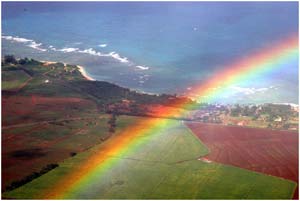Looking for life in the rainbow leg
Rainbow may be an important key to identifying habitable planets, a researcher claims. He said scattered light could reveal the presence of liquid water.
Assistant Professor Jeremy Bailey from the Center for Astrophysics at Macquarie University, Australia, said understanding how light scatters from liquid droplets on a planet's atmosphere could be an indicator. Sensitive about water vapor in its clouds.
 Bailey introduced the idea of using light polarization (a feature that helps create rainbow) to find liquid water in the latest issue of Astronomical Journal.
Bailey introduced the idea of using light polarization (a feature that helps create rainbow) to find liquid water in the latest issue of Astronomical Journal.
"The rainbow is born when light hits a drop of water scattered at a particular angle," he said. "This angle depends on the refractive index of the liquid, so for different types of liquids that exist in the clouds of other planets, we will see rainbows at different angles."
"That's a way to help us determine that Venus's clouds are droplets of concentrated sulfuric acid."
Because each type of liquid has its own scattering properties, Bailey thinks astronomers can use this method to detect water vapor in certain planet's atmosphere. Techniques can be used in parallel with the use of optical spectroscopy.
T. An
- Rare rainbow moments appear in the world
- Strange rainbow twin
- 7 little things to know about rainbows
- Capture a rare, circular rainbow image
- Rare 'rainbow rainbow' in the sky
- 5 consecutive rainbow glows in the sky of America
- The rare upside down rainbow rarely causes 'fever' in Britain
- Video: Record rainbow for nearly 9 hours in Taiwan, China
- Rare double rainbow
- Dragon hoses
- The double rainbow appears at the same aurora in the night sky
- Watch an extremely rare white rainbow in the North Pole
 'Fine laughs' - Scary and painful torture in ancient times
'Fine laughs' - Scary and painful torture in ancient times The sequence of numbers 142857 of the Egyptian pyramids is known as the strangest number in the world - Why?
The sequence of numbers 142857 of the Egyptian pyramids is known as the strangest number in the world - Why? History of the iron
History of the iron What is alum?
What is alum?